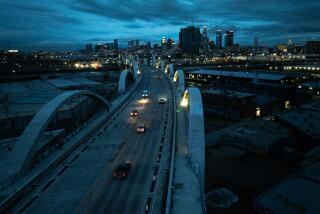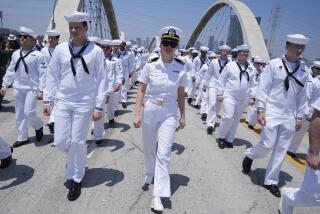25th-Birthday Bash for the Bridge That Changed San Pedro
- Share via
When the Vincent Thomas Bridge opened on Nov. 15, 1963, John Ara lost a job he loved.
Ara was the first mate on the ferry boat Islander, which each day transported hundreds of people across the Los Angeles Harbor’s main channel, from downtown San Pedro to Terminal Island and back. When the bridge opened, the ferry closed.
“I would still be there if it was running,” said Ara, who found work with the Port of Los Angeles. “Many of the ferry workers were very sad. . . . Still today I talk to people and they tell me, ‘Wouldn’t it have been nice if they kept the ferry?’ ”
Charles Boyd doesn’t feel that way at all. On Nov. 15, 1963, he left San Francisco to take a new job: toll-taker on the Vincent Thomas Bridge. He is still there.
“It actually created a career for me,” said Boyd, who is now captain in charge of the 16 toll-takers. “That’s the reason that I’m so appreciative of the Honorable Vincent Thomas.”
Today, San Pedro residents are celebrating the 25th anniversary of the bridge that the late California Assemblyman Vincent Thomas liked to call “my bridge.”
Bridge-Lighting Ceremony
Organizers have planned a brunch in honor of Thomas’ wife, Mary, a classic car tour, a yacht regatta, an antique airplane flyover, and--most importantly--a symbolic bridge-lighting ceremony in which 15,000 people are expected to walk across the graceful green span at dusk, carrying flashlights. The money from ticket sales will help defray the $170,000 cost of permanent decorative lights for the bridge’s main cables.
The festivities are more than just an anniversary celebration, however. They are an acknowledgement that the Vincent Thomas bridge forever changed San Pedro, as well as the lives of people like Ara and Boyd, who live and work there.
The advent of the bridge ended a tradition. No longer were cannery and shipyard workers able to walk to the ferry building at the foot of 6th Street, where they could find passage to their Terminal Island jobs any time of the day or night. Because it is against state law for a ferry service to compete with a state toll bridge, the ferries were eliminated.
From then on, if you wanted to go to Terminal Island, you had to drive or take a bus.
People Missed Ferries
Residents, including the many women who worked at the canneries, tried unsuccessfully to persuade public officials to retain the smaller of the two working ferries, which did not carry cars and thus would not have competed with the bridge.
“I know it caused a great deal of hardship to many of the ladies,” Ara recalled. “The women would get off at very odd hours from work. Sometimes they would get off at 3 or 4 o’clock in the morning . . . and then they had to wait until a bus came along, and I was told it would be as much as an hour to wait.”
And without the pedestrian traffic through San Pedro, the already-depressed Beacon Street area went into further decline.
Bill Oleson, who fought to retain the ferry service, recalled that fewer and fewer residents stopped to “make purchases in the downtown stores . . . or perhaps have a little libation before going home.”
But there were positive developments, too, Oleson recalled. People were glad to be rid of the long ferry lines, he said.
The loss of the ferry was also a gain for the Los Angeles Maritime Museum, which moved into the old ferry terminal. “It was the bridge that was responsible for . . . our inheriting this lovely building,” said Director William Lee.
And it was the bridge that, in part, was responsible for the rapid growth of the Port of Los Angeles in the 1970s. The bridge is credited with providing a crucial transportation link for trucks using the port, particularly after 1968, when the bridge was tied into the Harbor Freeway.
When containerized cargo began to dominate shipping more than a decade ago, the port was prepared.
Although another bridge, the Commodore Heim, links Terminal Island to Wilmington, port spokesman Mike Levitt said that without the Vincent Thomas, “there would be no way to successfully move a lot of cargo quickly and that would mean the difference between success and failure at the port.”
But no one foresaw that back in the 1940s and 50s, when Thomas was fighting for construction of the bridge.
No one, that is, except perhaps Thomas himself.
Thomas spent half his 38-year career in politics fighting for construction of a span that would link San Pedro with Terminal Island. It took 16 pieces of legislation and three governors before Thomas’ dream got approval.
And he was ridiculed for it every step of the way.
“The bridge to nowhere,” people called it.
His fellow legislators said it wouldn’t attract enough traffic.
They said it wasn’t needed.
And, once it was built, they said it wasn’t proper that Thomas should have it named after him while he was still alive.
Yet right off the bat, the $21-million bridge surpassed all expectations. Skeptics predicted that the bridge would serve fewer than 2,000 vehicles a day and would need 40 years to pay off its debt. In its first month of operation, the average number of vehicles that crossed the bridge each day was 9,631, and most of the debt was paid off within 20 years.
Today, 26,500 vehicles cross the bridge each day.
San Pedro residents speak of their “love” for the bridge, with its imposing towers and distinctive green color.
“I think even those that miss the old ferry, they are still proud of the bridge,” said Flora Baker, president of the San Pedro Bay Historical Society. “They love it. They’re proud of it.”
All of which serves to vindicate Vincent Thomas, who died in 1980, two years after losing a bitter election campaign that cost him his dream of serving 40 years in the Legislature.
“I’m very proud of the fact that my husband had the foresight and the determination and he didn’t give up,” said Mary Thomas. “People have forgotten that it took a man behind that bridge to make it possible, and that man was Vincent Thomas, my husband.”
SCHEDULE OF EVENTS The 25th anniversary celebration for the Vincent Thomas Bridge will begin at 10:30 a.m. Here are today’s events:
10:30 a.m.--Registration for more than 150 classic and antique cars that will ride in the car parade.
11 a.m.--Bridge closes to traffic. Construction begins on a replica of the bridge using canned foods to be donated to local food banks. Participants are asked to bring cans to 435 N. Harbor Blvd., the parking lot of Ben’s Radiator Service.
11:30-3:30 p.m.--Children’s groups gather for their walk on the bridge.
2 p.m.--A rededication ceremony on the Terminal Island side of the bridge will honor Thomas’ wife, Mary.
2:30-4 p.m.--The antique car parade begins on Harbor Boulevard. At the same time, a ship parade and an antique airplane flyover is scheduled.
4 p.m.--Bridge walkers will gain entry to the bridge after purchasing tickets at booths on both the San Pedro and Terinal Island sides. Tickets are $15 for a T-shirt and flashlight, or $5 for a flashlight only.
5:15 p.m.--Symbolic lighting of the bridge.
6 p.m.--Bridge reopens to traffic.
More to Read
Sign up for Essential California
The most important California stories and recommendations in your inbox every morning.
You may occasionally receive promotional content from the Los Angeles Times.










